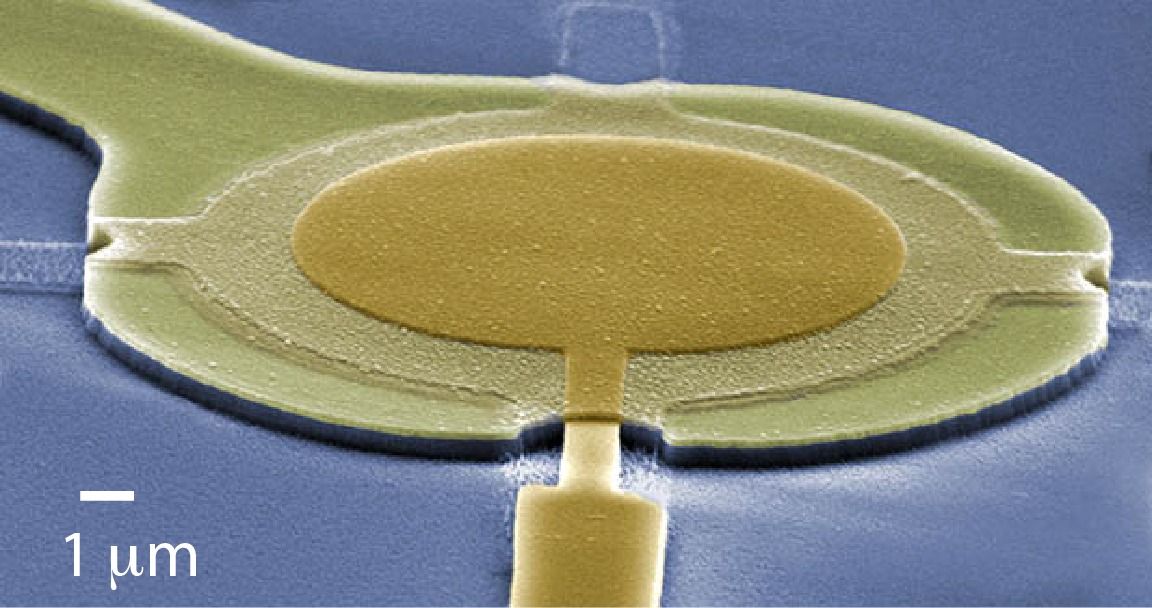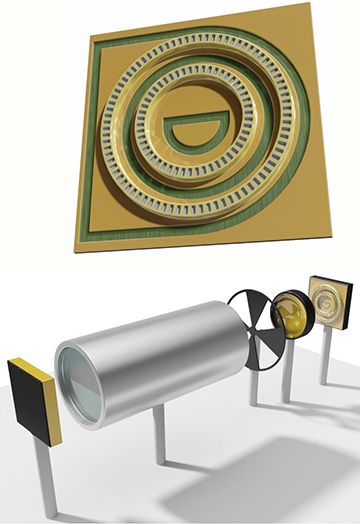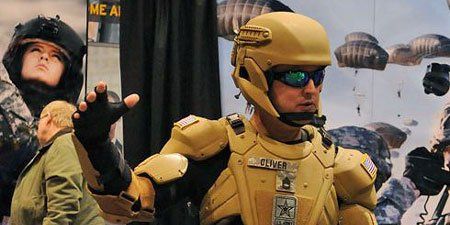Page 10735
Oct 31, 2016
Researchers nearly reach quantum limit with nanodrums
Posted by Karen Hurst in categories: encryption, quantum physics
Extremely accurate measurements of microwave signals can potentially be used for data encryption based on quantum cryptography and other purposes.
Researchers at Aalto University and the University of Jyväskylä have developed a new method of measuring microwave signals extremely accurately. This method can be used for processing quantum information, for example, by efficiently transforming signals from microwave circuits to the optical regime.
Oct 31, 2016
Toward Handheld QCL Sensors
Posted by Karen Hurst in categories: computing, quantum physics
In the TU Wien design, quantum cascade heterostructures are arrayed within concentric ring-shaped waveguides (top; diameter of outer ring is 400 microns), and can act as both sources and detectors of light on the same chip. In the specific setup tested by the lab (bottom), one of the ring structures (on the right), acting in QCL mode, sends its light through a chamber containing the gas to be analyzed. The beam is reflected by a mirror (on the left) and sent back through the chamber, to be picked up by the other ring structure, acting in detector mode. [Image: TU Wien]
Quantum cascade lasers (QCL) excel as mid-infrared light sources, a characteristic that has made them a linchpin in many environmental and industrial gas-sensing applications. But though QCLs themselves can be quite small, actually setting up a sensor system requires other elements beyond the laser, which can make it tough to design compact devices ready for field use.
A team of scientists from the Vienna University of Technology (TU Wien), Austria, now offers a concept that the group believes could make designing handheld QCL-based sensors a lot easier. The key: a clever scheme that combines the laser and the detector on a single chip less than half a millimeter across (ACS Photon., doi: 10.1021/acsphotonics.6b00603).
Oct 31, 2016
US Special Operations Command plans to have Iron Man suit prototypes ready to go by 2018
Posted by Sean Brazell in category: futurism
Oct 31, 2016
VERE’s Mind Control Robots Give Patients Out-of-Body Experience
Posted by Carse Peel in categories: biotech/medical, robotics/AI, virtual reality
Ready to leave your body behind? Scientists have developed robots that people can remotely control and embody using their minds, a breakthrough set to revolutionize the lives of paralyzed patients. The Virtual Embodiment and Robotic Re-Embodiment (VERE) project “aims at dissolving the boundary between the human body and surrogate representations in immersive virtual reality and physical reality,” meaning that people genuinely feel like the surrogate body is an extension of themselves. Three volunteers have tried out a prototype, and the results are promising.
“The feeling of actually embodying the robot was good, although needless to say, the sensation varied over time,” said Alessandro, a volunteer on the project, in an interview published Wednesday. “When the robot was stationary, the feeling of embodiment was low, but the moment I gave the first command or changed direction, there was this feeling of control and increased embodiment.”
The three volunteers, based in Italy, placed an electroencephalogram (EEG) cap on their heads that scanned for brain activity through the scalp. Patients were given a video feed of what a robot in Japan could see, superimposed with arrows. When the wearer focused on one arrow, the machine was able to detect the signal and send it remotely to the robot.
Continue reading “VERE’s Mind Control Robots Give Patients Out-of-Body Experience” »
Oct 31, 2016
This Team of Scientists Is Working to Clone a Woolly Mammoth
Posted by Carse Peel in category: futurism

We spoke with scientist Ben Novak, whose team is working to bring back extinct species like the woolly mammoth.
Oct 31, 2016
A Tiny Machine: UCSB electrical and computer engineers design an infinitesimal computing device
Posted by Carse Peel in categories: computing, engineering, nanotechnology, particle physics
Abstract: In 1959 renowned physicist Richard Feynman, in his talk “Plenty of Room at the Bottom,” spoke of a future in which tiny machines could perform huge feats. Like many forward-looking concepts, his molecule and atom-sized world remained for years in the realm of science fiction.
And then, scientists and other creative thinkers began to realize Feynman’s nanotechnological visions.
In the spirit of Feynman’s insight, and in response to the challenges he issued as a way to inspire scientific and engineering creativity, electrical and computer engineers at UC Santa Barbara have developed a design for a functional nanoscale computing device. The concept involves a dense, three-dimensional circuit operating on an unconventional type of logic that could, theoretically, be packed into a block no bigger than 50 nanometers on any side.
Oct 31, 2016
James Cameron Promises Innovation in ‘Avatar’ Sequels as He’s Feted
Posted by Carse Peel in category: innovation
Cameron and Douglas Trumbull were honored at the Society of Motion Picture and Television Engineers’ Centennial Gala.
Oct 31, 2016
Why the Many-Worlds Formulation of Quantum Mechanics Is Probably Correct
Posted by Andreas Matt in categories: mobile phones, quantum physics
 I have often talked about the Many-Worlds or Everett approach to quantum mechanics — here’s an explanatory video, an excerpt from From Eternity to Here, and slides from a talk. But I don’t think I’ve ever explained as persuasively as possible why I think it’s the right approach. So that’s what I’m going to try to do here. Although to be honest right off the bat, I’m actually going to tackle a slightly easier problem: explaining why the many-worlds approach is not completely insane, and indeed quite natural. The harder part is explaining why it actually works, which I’ll get to in another post.
I have often talked about the Many-Worlds or Everett approach to quantum mechanics — here’s an explanatory video, an excerpt from From Eternity to Here, and slides from a talk. But I don’t think I’ve ever explained as persuasively as possible why I think it’s the right approach. So that’s what I’m going to try to do here. Although to be honest right off the bat, I’m actually going to tackle a slightly easier problem: explaining why the many-worlds approach is not completely insane, and indeed quite natural. The harder part is explaining why it actually works, which I’ll get to in another post.
Any discussion of Everettian quantum mechanics (“EQM”) comes with the baggage of pre-conceived notions. People have heard of it before, and have instinctive reactions to it, in a way that they don’t have to (for example) effective field theory. Hell, there is even an app, universe splitter, that lets you create new universes from your iPhone. (Seriously.) So we need to start by separating the silly objections to EQM from the serious worries.
The basic silly objection is that EQM postulates too many universes. In quantum mechanics, we can’t deterministically predict the outcomes of measurements. In EQM, that is dealt with by saying that every measurement outcome “happens,” but each in a different “universe” or “world.” Say we think of Schrödinger’s Cat: a sealed box inside of which we have a cat in a quantum superposition of “awake” and “asleep.” (No reason to kill the cat unnecessarily.) Textbook quantum mechanics says that opening the box and observing the cat “collapses the wave function” into one of two possible measurement outcomes, awake or asleep. Everett, by contrast, says that the universe splits in two: in one the cat is awake, and in the other the cat is asleep. Once split, the universes go their own ways, never to interact with each other again.
Continue reading “Why the Many-Worlds Formulation of Quantum Mechanics Is Probably Correct” »
Oct 31, 2016
No Technology Thrives Alone: Progress Is All About Convergence
Posted by Elmar Arunov in categories: biotech/medical, business, computing, Ray Kurzweil
15 years ago, Ray Kurzweil published one of the most significant essays in the history of futurism: “The Law of Accelerating Returns.” This piece showcased the immense power of exponential technology versus linear technology and became a pivotal concept for anyone trying to anticipate what the future held.
The essay predicted advances in business and technology with eerie precision, including how exponential growth would ripple through any technology that became an information technology, such as computing, biotechnology, or energy.
Continue reading “No Technology Thrives Alone: Progress Is All About Convergence” »















